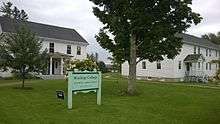Sterling College (Vermont)
 | |
| Motto | Working Hands - Working Minds |
|---|---|
| Type | Environmental Stewardship |
| Established | 1958 |
| Endowment | $1.1 million |
| President | Matthew Derr |
Academic staff | 45[1] |
| Students | 125 |
| Location |
Craftsbury Common, Vermont, U.S. 44°39′08″N 72°22′56″W / 44.6523°N 72.3823°W / 44.6523; -72.3823Coordinates: 44°39′08″N 72°22′56″W / 44.6523°N 72.3823°W / 44.6523; -72.3823 |
| Website | http://www.sterlingcollege.edu/ |
|
| |
Sterling College is an undergraduate college of environmental stewardship located in Craftsbury Common, in the U.S. state of Vermont. Sterling is one of seven colleges in the Work College Consortium and its curriculum is focused on environmental stewardship through Ecology, Environmental Humanities, Outdoor Education, Sustainable Agriculture, and Sustainable Food Systems. The college is accredited by the New England Association of Schools and Colleges.
Early history
Sterling School was founded in 1958 as a boys' college preparatory school by former Berkshire School faculty member Norman Rioux. The school's educational philosophy was influenced by that of Outward Bound founder Kurt Hahn. The school's transition to higher education in the 1970s began with the Academic Short Course in Outdoor Leadership, a 21-day program. In 1974, Sterling School was faced with closure and a small group of faculty launched the educational model that became Sterling College.
College history
In 1974, a small group of faculty established an academic year-long program similar to Outward Bound programs known as Grassroots Project in Vermont at Sterling Institute. By 1983, Sterling had developed into an accredited college offering an Associate of Arts degree in resource management with full accreditation by the New England Association of Schools and Colleges granted in 1987.
Since 1997, Sterling College has been accredited as a four-year college. It awards Bachelor of Arts degrees in Ecology, Environmental Humanities, Outdoor Education, and Sustainable Agriculture & Food Systems. Sterling College joined the Work Colleges Consortium in 1999.
In 2013, Sterling College announced that it would be the first college in Vermont, and the third college in the nation, to divest its endowment from fossil fuel extractors.[2]
Academics
.jpg)
The Sterling College Environmental Stewardship educational model of study, work, and community represents a challenging and overlapping set of theory-based and applied learning experiences.
Sterling defines Environmental Stewardship as our understanding of the natural world (Ecology), interpretation of the human experience with the natural world (Environmental Humanities), understanding human adaptation of and to the natural world (Sustainable Agriculture & Food Systems), and preparation of ourselves and others for experience in and with the natural world (Outdoor Education).
Among the most valued elements of a Sterling College education is the tradition of Expedition, including a four-day and three-night winter wilderness trek. The College celebrates the 50th anniversary of Expedition in 2014-15.
Besides its majors, Sterling College has minors in Sustainable Food Systems, Draft Horse Management, Natural History, and Climate Justice. Sterling College is the first college in the nation to offer a minor in Draft Horse Management.[3]
In 2013, Sterling College created the Rian Fried Center for Sustainable Agriculture and Food Systems. Named for the late Trustee, it is to be the center point for the college's focus on both sustainable agriculture and sustainable food systems.[4]
Sterling College also launched a continuing education program in 2013, with a series of 2- and 4-week short courses. The first course offered was a two-week cheese making intensive in partnership with the Cellars at Jasper Hill.[5] Other courses feature guest faculty such as Sandor Katz,[6] John Elder, Rowan Jacobsen, Ginger Strand, and Clare Walker Leslie.[7]
In 2014, Sterling College also announced a partnership with Yestermorrow Design/Build School.[8]
Campus
The primary campus is 130 acres (53 ha). It has 14 buildings including a woodworking shop and a library. Outdoor teaching facilities include a managed woodlot, a challenge course, a 30 feet (9.1 m) climbing tower, managed gardens, and a working livestock farm with two solar powered barns. Much of what is grown and raised on campus is consumed in the dining hall. Sterling produces approximately 18% of its own food. In 2015, Sterling College was ranked the #1 college in America for serving real food by the Real Food Challenge.[9]
References
- ↑ "College Overview - Sterling College". Peterson's. 2006-10-23. Retrieved 2007-01-26.
- ↑ "Fossil Free – Commitments". Gofossilfree.org. Retrieved 2016-10-12.
- ↑ "Minor In Draft Horsing? Well Yes, At Sterling College". Farmprogress.com. 2013-08-30. Retrieved 2016-10-12.
- ↑ "Sterling College Launches Sustainable Ag and Food Systems Center". WAMC. 2013-08-27. Retrieved 2016-10-12.
- ↑ Palmer, Hannah. "Sterling College Introduces Artisan Cheesemaking Intensive | Food News | Seven Days | Vermont's Independent Voice". Sevendaysvt.com. Retrieved 2016-10-12.
- ↑ Levitt, Alice (2014-01-29). "Sandor Katz to Teach Fermentation at Sterling College | Bite Club". Sevendaysvt.com. Retrieved 2016-10-12.
- ↑ "New writing workshop announced at Sterling College". Vtdigger.org. 2014-02-24. Retrieved 2016-10-12.
- ↑ "Sterling College, Yestermorrow Design/Build announce partnership". VTDigger. 2014-02-23. Retrieved 2016-10-12.
- ↑ "For real food, go to Sterling College". Burlingtonfreepress.com. 2015-01-15. Retrieved 2016-10-12.